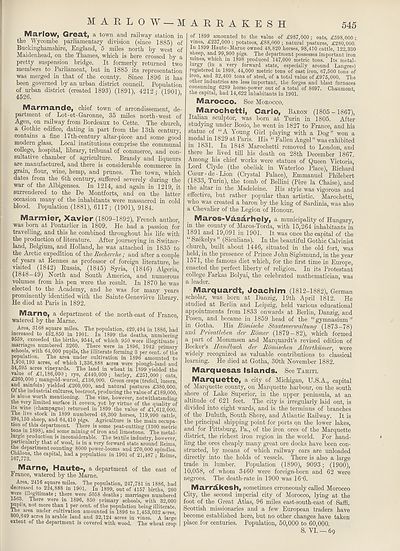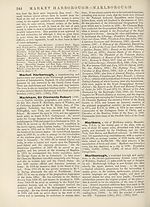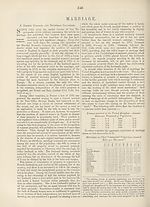New volumes of the Encyclopædia Britannica > Volume 30, K-MOR
(579) Page 545
Download files
Complete book:
Individual page:
Thumbnail gallery: Grid view | List view

MARLOW — M
Marlow, Great, a town and railway station in
the Wycombe parliamentary division (since 1885) of
Buckinghamshire, England, 5 miles north by west of
Maidenhead, on the Thames, which is here crossed by a
pretty suspension bridge. It formerly returned two
members to Parliament, but in 1885 its representation
was merged in that of the county. Since 1896 it has
been governed by an urban district council. Population
of urban district (created 1893) (1891), 4212 ; (1901),
4526.
Marmande, chief town of arrondissement, de¬
partment of Lot-et-Garonne, 35 miles north-west of
Agen, on railway from Bordeaux to Cette. The church,
a Gothic edifice, dating in part from the 13th century,
contains a fine 17th-century altar-piece and some good
modern glass. Local institutions comprise the communal
college, hospital, library, tribunal of commerce, and con¬
sultative chamber of agriculture. Brandy and liqueurs
are manufactured, and there is considerable commerce in
grain, flour, wine, hemp, and prunes. The town, which
dates from the 6th century, suffered severely during the
war of the Albigenses. In 1214, and again in 1219, it
surrendered to the De Montforts, and on the latter
occasion many of the inhabitants were massacred in cold
blood. Population (1881), 6117; (1901), 9184.
Marmier, Xavier (1809-1892), French author,
was born at Pontarlier in 1809. He had a passion for
travelling, and this he combined throughout his life with
the production of literature. After journeying in Switzer¬
land, Belgium, and Holland, he was attached in 1835 to
the Arctic expedition of the Recherche ; and after a couple
of years at Rennes as professor of foreign literature, he
visited (1842) Russia, (1845) Syria, (1846) Algeria,
(1848-49) North and South America, and numerous
volumes from his pen were the result. In 1870 he was
elected to the Academy, and he was for many years
prominently identified with the Sainte-Genevieve library.
He died at Paris in 1892.
Marne, a department of the north-east of France,
watered by the Marne.
Area, 3168 square miles. The population, 429,494 in 1886 had
increased to 432,850 in 1901. In 1899 the deaths, numbering
9559, exceeded the births, 9544, of which 950 were illegitimate :
marriages numbered 3260. There were in 1896, 1042 primary
schools, with 64,000 pupils, the illiterate forming 3 per cent, of the
population. The area under cultivation in 1896 amounted to
1,910,193 acres, of which 1,336,888 acres were plough-land and
34,595 acres vineyards. The land in wheat in 1899 yielded the
value of £1,186,000 ; rye, £440,000; barley, £251,000; oats,
£260,000 ; mangold-wurzel, £136,000. Green crops (trefoil, lucern,
and sainfoin) yielded £260,000, and natural pastures £380,000.
Of the industrial cultures, beetroot, producing the value of £189,000,
is alone worth mentioning. The vine, however, notwithstanding
the very limited surface it covers, yet by virtue of the quality of
its wine (champagne) returned in 1899 the value of £1,612,000.
Ihe live stock in 1899 numbered 48,300 horses, 119,990 cattle,
294,150 sheep, and 64,410 pigs. Agriculture is the main occupa¬
tion of this department. There is some peat-cutting (1300 metric
tons m 1898), and some mining of iron and limestone. The metal-
lurgic production is inconsiderable. The textile industry, however,
particularly that of wool, is in a very forward state around Reims,
the department counting 8000 power-looms and 270,000 spindles.
107 TT^’ the Capita1, had a P°Pulation in 1901 °f 21,487 ; Reims,
Marne, Haute-, a department of the east of
France, watered by the Marne.
Area, 2416 square miles. The population, 247,781 in 1886, had
decreased to 224,888 in 1901. In 1899, out of 4157 births, 260
1 nv?ltimate ’ 4here were 5058 deaths ; marriages numbered
1563. Ihere were in 1896, 850 primary schools, with 32,000
pupils, not more than 1 per cent, of the population being illiterate.
/rea Und.er cultivation amounted in 1896 to 1,453,032 acres,
o00,649 acres in arable land and 32,124 acres in vines. A large
extent of the department is covered with wood. The wheat crop
ARRAKESH 545
of 1899 amounted to the value of £987,000 ; oats, £598,000 ;
vines, £237,000; potatoes, £88,000; natural pastures, £280,000.
In 1899 Haute-Marne owned 48,820 horses, 98,410 cattle, 122,330
sheep, and 99,900 pigs. The department possesses important iron
mines, which in 1898 produced 147,000 metric tons. Its metal-
lurgy (bi _ a very forward state, especially around Langres)
registered in 1898, 44,000 metric tons of cast iron, 67,500 tons of
iron, and 32,400 tons of steel, of a total value of £975,000. The
other industries are less important, the forges and blast furnaces
consuming 6289 horse-power out of a total of 8697. Chaumont,
the capital, had 14,622 inhabitants in 1901.
Marocco. See Morocco.
Marochetti, Carlo, Baron (1805- 1867),
Italian sculptor, was born at Turin in 1805. After
studying under Bosio, he went in 1827 to France, and his
statue of “A Young Girl playing with a Dog” won a
medal in 1829 at Paris. His “ Fallen Angel” was exhibited
in 1831. In 1848 Marochetti removed to London, and
there he lived till his death on 28th December 1867.
Among his chief works were statues of Queen Victoria,
Lord Clyde (the obelisk in Waterloo Place), Richard
Cceur - de - Lion (Crystal Palace), Emmanuel Philebert
(lb33, Turin), the tomb of Bellini (Pere la Chaise), and
the altar in the Madeleine. His style was vigorous and
effective, but rather popular than artistic. Marochetti,
who was created a baron by the king of Sardinia, was also
a Chevalier of the Legion of Honour.
Maros-Vasarhelly, a municipality of Hungary,
in the county of Maros-Torda, with 15,264 inhabitants in
1891 and 19,091 in 1901. It was once the capital of the
Szekelys (Siculians). In the beautiful Gothic Calvinist
church, built about 1446, situated in the old fort, was
held, in the presence of Prince John Sigismund, in the year
1571, the famous diet which, for the first time in Europe,
enacted the perfect liberty of religion. In its Protestant
college Farkas Bolyai, the celebrated mathematician, was
a leader.
Marquartit, Joachim (1812-1882), German
scholar, was born at Danzig, 19th April 1812. He
studied at Berlin and Leipzig, held various educational
appointments from 1833 onwards at Berlin, Danzig, and
Posen, and became in 1859 head of the “gymnasium”
in Gotha. His Romische Staatsverwaltung (1873-78)
and Privatleben der Romer (1879-82), which formed
a part of Mommsen and Marquardt’s revised edition of
Becker’s Handbuch der Rdmischen Alterthurner, were
widely recognized as valuable contributions to classical
learning. He died at Gotha, 30th November 1882.
Marquesas Islands. See Tahiti.
Marquette, a city of Michigan, U.S.A., capital
of Marquette county, on Marquette harbour, on the south
shore of Lake Superior, in the upper peninsula, at an
altitude of 621 feet. The city is irregularly laid out, is
divided into eight wards, and is the terminus of branches
of the Duluth, South Shore, and Atlantic Railway. It is
the principal shipping point for ports on the lower lakes,
and for Pittsburg, Pa., of the iron ores of the Marquette
district, the richest iron region in the world. For hand- »
ling the ores cheaply many great ore docks have been con¬
structed, by means of which railway cars are unloaded
directly into the holds of vessels. There is also a large
trade in lumber. Population (1890), 9093; (1900),
10,058, of whom 3460 were foreign-born and 62 were
negroes. The death-rate in 1900 was 16'6.
Marrakesh, sometimes erroneously called Morocco
City, the second imperial city of Morocco, lying at the
foot of the Great Atlas, 96 miles east-south-east of Saffi.
Scottish missionaries and a few European traders have
become established here, but no other changes have taken
place for centuries. Population, 50,000 to 60,000.
S. VI. — 69
Marlow, Great, a town and railway station in
the Wycombe parliamentary division (since 1885) of
Buckinghamshire, England, 5 miles north by west of
Maidenhead, on the Thames, which is here crossed by a
pretty suspension bridge. It formerly returned two
members to Parliament, but in 1885 its representation
was merged in that of the county. Since 1896 it has
been governed by an urban district council. Population
of urban district (created 1893) (1891), 4212 ; (1901),
4526.
Marmande, chief town of arrondissement, de¬
partment of Lot-et-Garonne, 35 miles north-west of
Agen, on railway from Bordeaux to Cette. The church,
a Gothic edifice, dating in part from the 13th century,
contains a fine 17th-century altar-piece and some good
modern glass. Local institutions comprise the communal
college, hospital, library, tribunal of commerce, and con¬
sultative chamber of agriculture. Brandy and liqueurs
are manufactured, and there is considerable commerce in
grain, flour, wine, hemp, and prunes. The town, which
dates from the 6th century, suffered severely during the
war of the Albigenses. In 1214, and again in 1219, it
surrendered to the De Montforts, and on the latter
occasion many of the inhabitants were massacred in cold
blood. Population (1881), 6117; (1901), 9184.
Marmier, Xavier (1809-1892), French author,
was born at Pontarlier in 1809. He had a passion for
travelling, and this he combined throughout his life with
the production of literature. After journeying in Switzer¬
land, Belgium, and Holland, he was attached in 1835 to
the Arctic expedition of the Recherche ; and after a couple
of years at Rennes as professor of foreign literature, he
visited (1842) Russia, (1845) Syria, (1846) Algeria,
(1848-49) North and South America, and numerous
volumes from his pen were the result. In 1870 he was
elected to the Academy, and he was for many years
prominently identified with the Sainte-Genevieve library.
He died at Paris in 1892.
Marne, a department of the north-east of France,
watered by the Marne.
Area, 3168 square miles. The population, 429,494 in 1886 had
increased to 432,850 in 1901. In 1899 the deaths, numbering
9559, exceeded the births, 9544, of which 950 were illegitimate :
marriages numbered 3260. There were in 1896, 1042 primary
schools, with 64,000 pupils, the illiterate forming 3 per cent, of the
population. The area under cultivation in 1896 amounted to
1,910,193 acres, of which 1,336,888 acres were plough-land and
34,595 acres vineyards. The land in wheat in 1899 yielded the
value of £1,186,000 ; rye, £440,000; barley, £251,000; oats,
£260,000 ; mangold-wurzel, £136,000. Green crops (trefoil, lucern,
and sainfoin) yielded £260,000, and natural pastures £380,000.
Of the industrial cultures, beetroot, producing the value of £189,000,
is alone worth mentioning. The vine, however, notwithstanding
the very limited surface it covers, yet by virtue of the quality of
its wine (champagne) returned in 1899 the value of £1,612,000.
Ihe live stock in 1899 numbered 48,300 horses, 119,990 cattle,
294,150 sheep, and 64,410 pigs. Agriculture is the main occupa¬
tion of this department. There is some peat-cutting (1300 metric
tons m 1898), and some mining of iron and limestone. The metal-
lurgic production is inconsiderable. The textile industry, however,
particularly that of wool, is in a very forward state around Reims,
the department counting 8000 power-looms and 270,000 spindles.
107 TT^’ the Capita1, had a P°Pulation in 1901 °f 21,487 ; Reims,
Marne, Haute-, a department of the east of
France, watered by the Marne.
Area, 2416 square miles. The population, 247,781 in 1886, had
decreased to 224,888 in 1901. In 1899, out of 4157 births, 260
1 nv?ltimate ’ 4here were 5058 deaths ; marriages numbered
1563. Ihere were in 1896, 850 primary schools, with 32,000
pupils, not more than 1 per cent, of the population being illiterate.
/rea Und.er cultivation amounted in 1896 to 1,453,032 acres,
o00,649 acres in arable land and 32,124 acres in vines. A large
extent of the department is covered with wood. The wheat crop
ARRAKESH 545
of 1899 amounted to the value of £987,000 ; oats, £598,000 ;
vines, £237,000; potatoes, £88,000; natural pastures, £280,000.
In 1899 Haute-Marne owned 48,820 horses, 98,410 cattle, 122,330
sheep, and 99,900 pigs. The department possesses important iron
mines, which in 1898 produced 147,000 metric tons. Its metal-
lurgy (bi _ a very forward state, especially around Langres)
registered in 1898, 44,000 metric tons of cast iron, 67,500 tons of
iron, and 32,400 tons of steel, of a total value of £975,000. The
other industries are less important, the forges and blast furnaces
consuming 6289 horse-power out of a total of 8697. Chaumont,
the capital, had 14,622 inhabitants in 1901.
Marocco. See Morocco.
Marochetti, Carlo, Baron (1805- 1867),
Italian sculptor, was born at Turin in 1805. After
studying under Bosio, he went in 1827 to France, and his
statue of “A Young Girl playing with a Dog” won a
medal in 1829 at Paris. His “ Fallen Angel” was exhibited
in 1831. In 1848 Marochetti removed to London, and
there he lived till his death on 28th December 1867.
Among his chief works were statues of Queen Victoria,
Lord Clyde (the obelisk in Waterloo Place), Richard
Cceur - de - Lion (Crystal Palace), Emmanuel Philebert
(lb33, Turin), the tomb of Bellini (Pere la Chaise), and
the altar in the Madeleine. His style was vigorous and
effective, but rather popular than artistic. Marochetti,
who was created a baron by the king of Sardinia, was also
a Chevalier of the Legion of Honour.
Maros-Vasarhelly, a municipality of Hungary,
in the county of Maros-Torda, with 15,264 inhabitants in
1891 and 19,091 in 1901. It was once the capital of the
Szekelys (Siculians). In the beautiful Gothic Calvinist
church, built about 1446, situated in the old fort, was
held, in the presence of Prince John Sigismund, in the year
1571, the famous diet which, for the first time in Europe,
enacted the perfect liberty of religion. In its Protestant
college Farkas Bolyai, the celebrated mathematician, was
a leader.
Marquartit, Joachim (1812-1882), German
scholar, was born at Danzig, 19th April 1812. He
studied at Berlin and Leipzig, held various educational
appointments from 1833 onwards at Berlin, Danzig, and
Posen, and became in 1859 head of the “gymnasium”
in Gotha. His Romische Staatsverwaltung (1873-78)
and Privatleben der Romer (1879-82), which formed
a part of Mommsen and Marquardt’s revised edition of
Becker’s Handbuch der Rdmischen Alterthurner, were
widely recognized as valuable contributions to classical
learning. He died at Gotha, 30th November 1882.
Marquesas Islands. See Tahiti.
Marquette, a city of Michigan, U.S.A., capital
of Marquette county, on Marquette harbour, on the south
shore of Lake Superior, in the upper peninsula, at an
altitude of 621 feet. The city is irregularly laid out, is
divided into eight wards, and is the terminus of branches
of the Duluth, South Shore, and Atlantic Railway. It is
the principal shipping point for ports on the lower lakes,
and for Pittsburg, Pa., of the iron ores of the Marquette
district, the richest iron region in the world. For hand- »
ling the ores cheaply many great ore docks have been con¬
structed, by means of which railway cars are unloaded
directly into the holds of vessels. There is also a large
trade in lumber. Population (1890), 9093; (1900),
10,058, of whom 3460 were foreign-born and 62 were
negroes. The death-rate in 1900 was 16'6.
Marrakesh, sometimes erroneously called Morocco
City, the second imperial city of Morocco, lying at the
foot of the Great Atlas, 96 miles east-south-east of Saffi.
Scottish missionaries and a few European traders have
become established here, but no other changes have taken
place for centuries. Population, 50,000 to 60,000.
S. VI. — 69
Set display mode to:
![]() Universal Viewer |
Universal Viewer | ![]() Mirador |
Large image | Transcription
Mirador |
Large image | Transcription
Images and transcriptions on this page, including medium image downloads, may be used under the Creative Commons Attribution 4.0 International Licence unless otherwise stated. ![]()
| Encyclopaedia Britannica > New volumes of the Encyclopædia Britannica > Volume 30, K-MOR > (579) Page 545 |
|---|
| Permanent URL | https://digital.nls.uk/193575028 |
|---|
| Attribution and copyright: |
|
|---|---|
| Shelfmark | EB.18 |
|---|---|
| Description | Ten editions of 'Encyclopaedia Britannica', issued from 1768-1903, in 231 volumes. Originally issued in 100 weekly parts (3 volumes) between 1768 and 1771 by publishers: Colin Macfarquhar and Andrew Bell (Edinburgh); editor: William Smellie: engraver: Andrew Bell. Expanded editions in the 19th century featured more volumes and contributions from leading experts in their fields. Managed and published in Edinburgh up to the 9th edition (25 volumes, from 1875-1889); the 10th edition (1902-1903) re-issued the 9th edition, with 11 supplementary volumes. |
|---|---|
| Additional NLS resources: |
|

